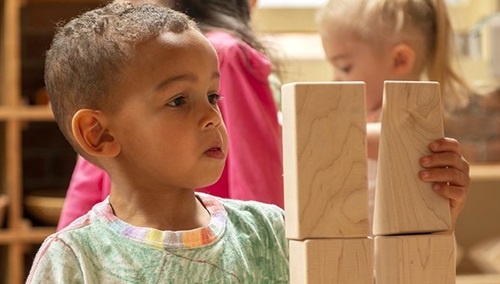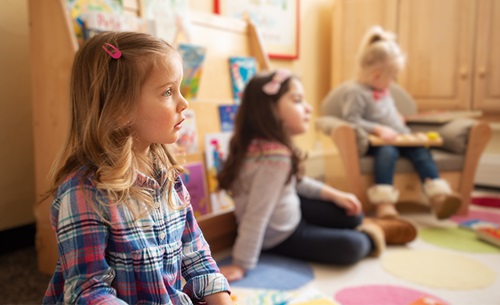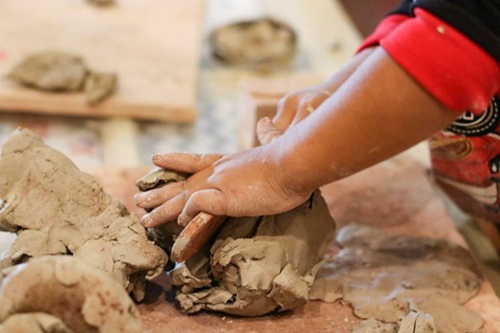Providing Opportunities for Risk-Taking
The Importance of Creating a "Yes" Environment for Children
|
June 2016
When was the last time you took a risk? How did you feel? When children take risks and succeed, they feel proud and self-confident. When things don’t go as planned, they feel frustrated, learn that things don’t always happen as predicted, and maybe even decide to try it again.
Risk is a vital component of children’s play. It allows children to be challenged, to face uncertainty, to problem-solve, to work with others to find a solution, and to think outside the box. All of these qualities serve to expand children’s cognitive, physical, and social-emotional abilities. They become the building blocks for later learning and managing of experiences, both throughout school and as an adult.
Allowing children to take risks in their play gives them the opportunity to develop the use of their judgment. When a child starts to climb the side of the play structure, our first instinct might be to say, “Don’t go up that high.” In taking away the experience from the child, however, he never learns what might be unsafe about climbing. He also never learns to balance his feet, grip tightly, and steady himself if he slips. He definitely doesn’t get the opportunity to figure out how to climb down after going up. He may later find himself in a situation—perhaps his friends are climbing a tree in the neighborhood, out of view of an adult’s eye—in which he doesn’t feel comfortable participating because he never learned to climb. Or maybe he does climb and falls because he never learned how to do it!
Risk-taking can also occur in activities that are less gross motor-centered. A child can take a risk and explore gooey sensory materials. Perhaps a child who has never wanted to get her feet wet finally does, shoes and all. Risks can happen when exploring real tools, such as scissors or a mallet, that are a bit beyond the child’s developmental level. When the child decides to give it a try, even when the adults present don’t think he has the capability to do it, he is taking a risk.
When we support children in taking risks, we give them the chance to learn something new about themselves, their physical abilities, and their thought processes.
Allowing children to take appropriate risks in their play gives them the opportunity to develop the use of their judgement.
The role of the teacher
When creating a “yes” environment in the classroom, the most challenging thing for the teacher to provide may be opportunities for risk-taking. We may not feel at ease being taken out of our comfort zones to allow for activities we feel aren’t safe. We might want to step in and move the child, or say, “Don’t do that. It’s not safe.” Doing these things, though, tells the child she is not competent and cannot be trusted to figure out how to complete the task on her own. If she is not allowed to fall or push the limits of her abilities, she also never learns the feeling of pride she’ll achieve when she accomplishes the challenging activity all by herself.
The teacher’s role is to create a safe space in which children can take risks. We check the yard for hazardous objects, like broken glass or exposed nails, and we remove broken toys and equipment. We step in if it looks like a child might hurt himself or hurt another child. We stay close to a child who is climbing or balancing and remain calm to show the child that we trust her abilities. The main thing we have to do is to accept that there will be some risks in children’s play. Allowing those risks helps to expand their confidence, their thought-processes, their creativity, and their fine and gross motor abilities.
In the event that a child does get hurt, it’s important to remember that scrapes and bruises are a part of childhood. All children experience these small injuries. Children are still small, and if they fall, they’re not so far from the ground. Their bodies are resilient, and a bump doesn’t stop them for long. We remain nearby to comfort, give first aid, and encourage the child to think about what happened and perhaps try again.

The teacher's role is to create a safe, supportive space where children can take risks.
Opportunities for risk-taking
It’s important that we include spaces in our environments where children can challenge their physical abilities. They need to be able to learn to balance, hang, climb, and build the necessary muscles to do these things. When climbing areas are created with intention, they can also be created with safety in mind, by including tumbling mats or pillows to cushion children when they fall.
There are ways to promote risk in play that don’t involve gross motor. Giving children opportunities to experience messy play, whether it’s with water, mud, or paint, allows children to take risks through experimentation of materials. Letting a child get wet or muddy shows that you trust them to manage themselves and use the materials in a way that is comfortable for their bodies. (It also shows you understand that hands, feet, and clothing are washable!)

Giving children opportunities to experience messy play is an important form of risk-taking
Including open-ended materials is another way to promote risk. Simple wooden blocks, loose parts such as craft sticks and cardboard tubes, and costume items such as scarves and fabric remnants give children the chance to experiment with how they can be manipulated and to apply their creativity in new ways. Children can take risks by trying out different ideas, seeing if they work, and trying again if it doesn’t work the first time. Items from nature, such as sticks, rocks, or pinecones, can also be used in this way.
Just as crucial is the use of real tools in the classroom. Giving children an opportunity to use scissors on paper or mallets on clay helps them to learn how to use these tools properly. Putting them out in the classroom environment may be more about the process, how to hold scissors, rather than the product, paper cut into strips. Perhaps using real tools only happens when there is an adult available to supervise the activity, but allowing for these sorts of risk-taking opportunities helps the child build self-confidence and develop new skills.
When we allow children to take risks, not only do we give them opportunities to experience how much we trust them, we also allow them to learn how to trust themselves when trying out new things. Children can have safe experiences with risk-taking if we’re doing our jobs to guide them. We as teachers have to be open and willing to push the boundaries of our comfort zones at the same time that the children are testing out the limits of their own cognitive and gross motor abilities.
Read more from the author about creating a "yes" environment







